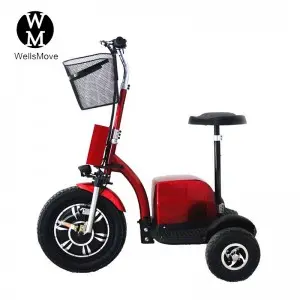Collision safety test of elderly three-wheeled scooters: a key step in protecting travel safety
Introduction
With the intensification of the global aging trend, elderly three-wheeled scooters, as a convenient means of transportation, have been loved by more and more elderly people. However, its safety issues have also attracted widespread attention. Collision safety testing is an important means to evaluate the ability of vehicles to protect passengers in accidents.
Safety status of elderly three-wheeled scooters
Elderly three-wheeled scooters are quite different from traditional cars in design and manufacturing, and their safety performance has also been questioned. Many elderly scooters have not been crash tested, and the body design lacks safety protection measures. For example, the shell of some vehicles is made of fiberglass paste, the tires are made of ordinary rubber, and the bumpers are also made of fiberglass paste, which has low bearing capacity and is easily damaged in the event of a collision. In addition, there are usually no seat belts in the car, the handling stability is poor, the brake components are thin and easy to damage, and the axle structure is unreasonable and easy to roll over. These design risks make the risk of passenger injury in elderly scooters extremely high in collision accidents.
Importance of collision safety testing
Collision safety testing is a key link in evaluating the ability of vehicles to protect passengers in collision accidents. By simulating real collision scenarios, we can intuitively understand the performance of the vehicle in an accident, including the integrity of the body structure, the degree of intrusion into the passenger compartment, the effectiveness of safety devices, etc. For elderly three-wheeled scooters, it is particularly important to conduct collision safety tests, because their user group is mainly the elderly, who are at a higher risk of injury in accidents. Through collision tests, safety hazards in vehicle design can be discovered, providing a basis for improvement and optimization, thereby improving the safety performance of the vehicle and ensuring the travel safety of the elderly.
Methods of collision safety testing
Collision safety tests usually include multiple test scenarios such as frontal collision, side collision, and rear-end collision. The frontal collision test simulates the vehicle’s frontal collision with a fixed obstacle at a certain speed to evaluate the energy absorption effect of the front end of the vehicle and the protection ability of the passenger compartment. The side collision test simulates the situation where the vehicle is hit from the side by other vehicles, focusing on the strength of the vehicle’s side structure and the protection measures for passengers. The rear-end collision test mainly evaluates the structural strength of the rear of the vehicle and the neck protection of the passengers. In addition to these common test scenarios, other special collision tests, such as rollover tests, can also be performed as needed to comprehensively evaluate the safety performance of the vehicle.
During the test, a dummy will be used to simulate the passenger, and the force data of the dummy during the collision, such as head acceleration and chest compression, will be collected through sensors to assess the risk of injury to the passenger. At the same time, the vehicle’s body structure, seat belts, airbags and other safety devices will be inspected and evaluated to ensure that they can function normally in a collision.
International safety standards and certification
In order to ensure the safety of elderly three-wheeled scooters, a series of safety standards and certification systems have been developed internationally. For example, the ISO 7176-8-1998 standard developed by the International Organization for Standardization (ISO) specifies the requirements and test methods for the static strength, impact strength and fatigue strength of wheelchairs (including elderly three-wheeled scooters). These standards provide clear guidance and basis for the collision safety test of elderly three-wheeled scooters.
In some countries and regions, elderly three-wheeled scooters are also required to pass relevant safety certifications, such as the European ECE certification and the American FMVSS certification. These certifications not only cover collision safety tests, but also include testing and evaluation of multiple aspects such as the vehicle’s braking performance, lighting system, and electrical system. Products that have passed these certifications can better ensure the travel safety of the elderly and provide reliable quality assurance for international wholesale buyers.
Measures to improve the collision safety of elderly three-wheeled scooters
In order to improve the collision safety of elderly three-wheeled scooters, the following aspects can be taken:
Optimize the body structure: Use high-strength steel or new composite materials to manufacture the body to increase the impact strength and energy absorption effect of the body. At the same time, the body structure should be reasonably designed to ensure that the impact force can be effectively dispersed in the collision and reduce the intrusion of the passenger compartment.
Equip with safety devices: Equip the vehicle with safety devices such as seat belts and airbags, and ensure that they can function normally in the collision. In addition, you can also consider installing anti-rollover devices to improve the stability of the vehicle.
Improve handling performance: Optimize the chassis design of the vehicle, lower the center of gravity, widen the wheels, and improve the handling stability and grip of the vehicle. At the same time, ensure that the braking system is sensitive and reliable and reduce the braking distance.
Strengthen quality supervision: Strengthen quality supervision of elderly three-wheeled scooter manufacturers to ensure that they are produced in strict accordance with relevant standards and certification requirements. Products that do not meet safety standards should be resolutely eliminated.
Conclusion
The collision safety test of elderly tricycles is an important part of ensuring the safety of elderly people’s travel. Through scientific and reasonable testing methods and strict international safety standard certification, the safety performance of the vehicle can be effectively improved.
Post time: Jul-18-2025



